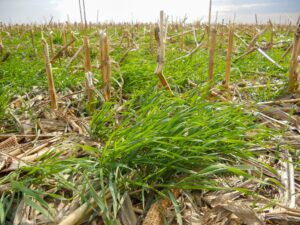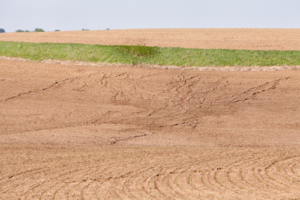By: 4R Plus
October 2018

Iowa experienced its third wettest September since records were taken, and the above-normal precipitation trend continued as the calendar flipped to October. Saturated fields are a frustration to farmers that want to complete this year’s corn and soybean harvest. Soil conservation experts urge farmers to take a close look at tillage practices, which can make a difference in a year like this one.
Farmers that have a no-till system have generally been able to get into fields before conventional-tilled fields, says Doug Adams, a farmer and NRCS soil conservation technician in the Humboldt County field office. He says cover crops provide even more soil structure benefits. “This fall is a case study for soil structure. Once you get the soil structure built back up, it’s able to support the equipment load,” he says.
Adams says this has been an eye-opening year for farmers that have a no-till system in place. “Of course there are still limits. We can’t access fields that are totally saturated, as water lubricates the soil particles and you can still cause compaction,” warns Adams, recalling a time when he was testing the differences in tillage systems.
“Before I went to 100 percent no-till on my soybean acres and strip-till on my corn acres, I had an area in my field that was still conventionally tilled,” explains Adams. “It was a wet spring. As soon as my wheels dropped off of the no-till soil and into the tilled soil, they sunk quite a ways. That’s how tillage disrupts our soil structure, as there’s nothing there to support the weight of the equipment.”

When Adams talks to farmers about soil structure and soil biology he stresses that improvement begins the day they quit tilling. “It takes three to five years from the point a farmer stops tilling before they will see a noticeable difference in soil structure and biological activity – although adding cover crops can cut that window in half,” he said. “If you run a tillage tool through the field this fall, you reset the clock back to day one.”
Adams is passionate about educating farmers on tillage practices and believes it causes the bulk of erosion issues on farms. “Any tillage destroys the soil structure and advances compaction,” he said. “Watch a new road being built. One of the first things they do is disk the soil back and forth. The disk breaks the soil down into fine particles and that results in compaction for the base of the road.”
This fall Adams encourages farmers to take a close look at their fields to see where the greatest erosion and compaction is occurring. “There are things farmers can do in their fields regardless of the topography, like no-till, strip-till and cover crops, to improve the soil and soil health.”
Adams encourages farmers to watch the new 4R Plus video that demonstrates the practices they can use on virtually all farms – whether the land is hilly or flat. After watching the video, he wants farmers to think about their farms and talk to their adviser about what conservation practices can be added to improve soil structure.
4R Plus has developed five videos to help producers make informed decisions to improve crop productivity, soil health and the quality of Iowa’s water.
- Click here to watch videos with information on conservation practices for Iowa’s farmland, including specific information for all fields, sloping fields, and flat, tile-drained fields.
- Click here to watch the nutrient stewardship video to learn more about 4R practices to best utilize nutrients in your fields.
- Click here to gain insight and information into the Iowa Nutrient Reduction Strategy.
Soil is our most important resource, says Adams. He wants farmers to pay close attention to the soil for future generations. “We need to figure out the causes of the problems in our fields and come up with long-term solutions,” he said. “If you have a problem that occurs eight out of 10 years, then you need a conservation practice to protect it. By changing tillage systems and keeping a living root in the soil to feed the carbon and microorganisms, we can improve the health of our soils.”



